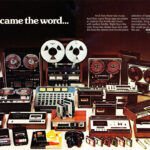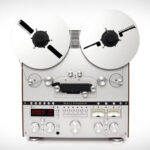If you’re a fan of vintage audio recordings, you know that reel-to-reel tapes offer a unique listening experience that can’t be replicated with modern digital formats. But if you want to preserve these tapes for years to come, it’s important to take proper care of them. In this article, we’ll explore the key factors that contribute to the longevity of reel-to-reel tapes, as well as the best practices for storage, cleaning, and maintenance.
Key Takeaways:
- Preserving reel-to-reel tapes is important for maintaining access to unique historical audio recordings.
- Proper storage conditions, cleaning, and careful handling can help extend the lifespan of reel-to-reel tapes.
- Digital preservation options are available for transferring reel-to-reel tapes to more durable formats.
- Professional restoration services may be necessary for severely damaged tapes.
- Ongoing preservation efforts, including periodic inspection and maintenance, can help ensure the longevity of reel-to-reel tapes.
Understanding Reel-to-Reel Tapes
Reel-to-reel tapes have played a significant role in the history of audio recording. The format was developed in the 1930s and remained the primary medium for commercial music production until the 1980s, when it was largely replaced by digital recording technologies.
Reel-to-reel tapes were also popular with home audio enthusiasts, who used them to record music, speeches, and other audio content. These vintage tapes offer a unique listening experience and are prized by collectors and audiophiles alike.
However,
preserving vintage reel-to-reel tapes can be a challenge. Magnetic tape is subject to deterioration over time, and environmental factors such as temperature and humidity can accelerate this process. In addition, the sheer size of reel-to-reel tapes can make storage and organization difficult.
To ensure that these valuable recordings are preserved for future generations, it is important to understand the unique preservation challenges posed by reel-to-reel tapes and to take measures to protect them from degradation.
Proper Storage Conditions
Proper storage conditions are crucial for the preservation of reel-to-reel tapes. The ideal temperature range for storage is between 60-70 degrees Fahrenheit with a relative humidity level of 30-50%. Extreme temperature fluctuations and high humidity can cause deterioration and damage to the tapes.
It is recommended to store the tapes vertically, and not horizontally, as this can prevent tape deformation. Labeling the tapes with a unique identifier and storing them in protective boxes or cases can also help prevent damage and aid in organization.
Exposure to light should be minimized as it can cause fading and discoloration. Keep the tapes away from direct sunlight and fluorescent lights, and instead store them in a dark and cool environment.
Avoid stacking tapes on top of each other or placing heavy objects on them, as this can cause physical damage such as warping or breaking. To further protect the tapes, consider placing them in a climate-controlled storage facility.
Cleaning and Maintenance
Proper cleaning and maintenance are essential to preserve the quality and lifespan of your reel-to-reel tapes. Regular maintenance can help prevent deterioration and ensure optimal playback. Here are some step-by-step instructions for cleaning your tapes:
- First, make sure to clean the tape recorder’s heads and rollers to prevent any debris or dust from sticking to the tape. Use a soft, lint-free cloth or cotton swab dipped in isopropyl alcohol to gently clean the surface.
- Next, inspect the tape for any visible debris or dirt. If necessary, use a soft-bristled brush or compressed air to remove any particles. Make sure to handle the tape carefully and avoid touching the surface with your fingers.
- If you notice any damage or tape slack, you may need to spool the tape onto a new reel. This can be a delicate process that requires some patience and care.
- Store your tapes in a cool, dry environment away from direct sunlight to avoid damage from heat and humidity. Make sure to label your tapes clearly and organize them in a way that is easy to find and access.
Remember to inspect your tapes periodically and consider seeking professional restoration services if you notice any significant damage or deterioration. With proper care and maintenance, your reel-to-reel tapes can provide years of enjoyment and preserve your cherished memories for future generations.
Handling with Care
Proper handling is critical to the longevity of reel-to-reel tapes. Direct contact with fingers can cause oils and dirt to accumulate on the tape, leading to degradation and poor playback quality. When handling the tape, it is recommended to wear cotton gloves to prevent contamination from oils and dirt on the skin.
Additionally, physical damage can occur if tapes are improperly stored or mishandled. Dropping or mishandling tapes can cause them to become warped or damaged, and exposure to heat or moisture can cause irreversible damage to the tape.
To prevent physical damage, it is important to store tapes in a secure, temperature-controlled environment. Avoid storing tapes near sources of heat or moisture, and handle them with care to avoid physical damage.
When transporting tapes, it is recommended to keep them in a protective case or box to prevent physical damage or exposure to environmental elements. With proper handling and storage, reel-to-reel tapes can be preserved for future generations to enjoy.
Digital Preservation Options
Preserving reel-to-reel tapes for the long term can be a challenging task, especially when dealing with deteriorated or damaged tapes. Fortunately, technology has provided new solutions for preserving and restoring vintage reel-to-reel tapes, allowing for better sound quality and the option to digitize tapes for future generations.
Digitization Techniques
Digitization is the process of converting analog audio signals into digital data, making it possible to store and reproduce sound in a more durable and accessible format. There are several methods for digitizing reel-to-reel tapes, including:
| Method |
Description |
| Direct Transfer |
Direct transfer involves playing the tape in real-time on a reel-to-reel player connected to a computer, which captures the audio and converts it into digital files. |
| Multi-track Transfer |
For multi-track tapes, each track is transferred separately and then synchronized to create a final digital version with individual tracks. |
| High-Resolution Transfer |
This method involves using specialized equipment to capture the audio in high-resolution formats, such as 24-bit/96kHz, providing superior sound quality to the original tape. |
Digitization can offer several benefits beyond preservation, including improved sound quality, easier access to the recordings, and the ability to share the recordings with others online or through physical media.
Restoring Digitized Tapes
Even after digitization, old tapes may still require restoration to improve their sound quality. Advanced digital tools and software can remove noise, pops, and clicks, and equalize the sound to produce a cleaner, clearer recording. The digitized files can also be stored in a variety of formats, including lossless compression formats like FLAC, to ensure the highest quality sound.
Preserving reel-to-reel tapes is crucial for maintaining a piece of audio history and sharing it with future generations. Digitization offers a practical and cost-effective way to preserve recordings and improve their sound quality, ensuring that vintage reel-to-reel tapes can be enjoyed for years to come.
Repairing Damaged Tapes
While proper storage and maintenance can prevent most damage to reel-to-reel tapes, they are not impervious to wear and tear. Over time, tapes can become brittle, develop cracks, or become distorted. Fortunately, there are several techniques you can use to restore damaged tapes and preserve their audio quality.
Splicing Broken or Damaged Sections
If a tape has a break, splice the broken sections together to repair the damage. You’ll need to use a reel-to-reel tape splicer to make a clean, secure connection. Make sure to use splicing tape that is specifically designed for use with reel-to-reel tapes, as other types of tape may damage the audio quality.
Addressing Sticky Shed Syndrome
Sticky shed syndrome is a common issue with older reel-to-reel tapes. Over time, the binder that holds the magnetic particles to the tape can break down, causing the tape to become sticky and difficult to play back. A professional restoration service can use a process called baking to temporarily restore the tape’s functionality. The tape is placed in a humidity-controlled oven for several hours, allowing the binder to soften and adhere to the tape more effectively.
While there are DIY methods for baking tapes, it’s not recommended. This process can be dangerous, and if done incorrectly, can cause further damage to the tape. If your tape is exhibiting signs of sticky shed syndrome, it’s best to seek the assistance of a professional tape restoration service.
Other Tape Problems
If your reel-to-reel tape has other issues like wrinkles, distorted edges, or creases, you can try to gently straighten the tape using a reel-to-reel tape degausser. For severe damage, it’s best to seek the assistance of a professional restoration service.
Overall, repairing damaged reel-to-reel tapes can be a delicate process that requires specialized equipment and expertise. If you’re unsure about how to repair a damaged tape, it’s best to seek the assistance of a professional restoration service. By taking the right steps to repair damaged tapes, you can ensure that your reel-to-reel audio recordings remain playable for years to come.
Professional Restoration Services
For severely damaged or deteriorated reel-to-reel tapes, seeking professional restoration services may be the best option. Professional restorers have the expertise and equipment necessary to tackle even the most difficult restoration projects.
When selecting a restoration service, it is important to choose a company with a proven track record and extensive experience in
reel-to-reel tape restoration. Look for a company that offers a range of restoration services, including cleaning, repair, and digitization.
One of the major benefits of professional restoration services is access to advanced restoration techniques not available to the average person. These techniques can include tape baking, chemical cleaning, and mechanical splicing, which can restore tapes to their original condition.
Professional restorers also have the ability to transfer tapes to digital formats, which can extend the life of the recordings and make them more accessible for future use. Before committing to a restoration service, be sure to discuss your preservation goals and any concerns you may have about the process.
Overall, professional restoration services can be a valuable investment for preserving and protecting your reel-to-reel tape collection.
Future Preservation Efforts
Preserving reel-to-reel tapes for long-term storage requires ongoing effort and attention to ensure their longevity. It is important to periodically inspect the tapes and reassess the storage conditions to ensure they are still optimal. Environmental factors such as temperature, humidity, and light exposure can change over time, and adjustments may need to be made to maintain the ideal storage conditions.
In addition to regular maintenance, it is also important to consider the future of reel-to-reel tapes and their preservation. As technology and storage methods continue to evolve, it is crucial to stay up-to-date with preservation techniques and digital transfer options.
While
preserving vintage reel-to-reel tapes is a labor of love, it is an effort that ensures the preservation of important historical recordings. By maintaining and caring for these tapes, we can ensure that future generations can enjoy and appreciate the unique audio recordings that reel-to-reel tapes offer.
Sharing the Joy of Reel-to-Reel Tapes
Preserving vintage reel-to-reel tapes isn’t just about ensuring their longevity, it’s also about sharing the joy of these unique recordings with others. Whether it’s listening to classic jazz recordings or rediscovering old family recordings, reel-to-reel tapes offer a window into the past and evoke a sense of nostalgia that is unmatched by modern digital formats.
By preserving vintage reel-to-reel tapes, we can not only enjoy and share these recordings with others, but we can also pass down a piece of history to future generations. It’s a way to connect with the past and keep our memories alive for years to come.
So, whether you’re a collector, a historian, or simply someone who appreciates the value of preserving vintage recordings, reel-to-reel tapes are a tangible way to experience the past and share its magic with others.
Conclusion
Preserving reel-to-reel tapes for long-term storage is a crucial task that requires attention to detail and proper care. By understanding reel-to-reel tapes, providing proper storage conditions, cleaning and maintaining them regularly, and handling them with care, these unique audio recordings can last for decades.
As technology advances, it is also important to consider digitization options for long-term preservation and future enjoyment. Repairing damaged tapes and seeking professional restoration services can also help salvage deteriorated tapes.
It is important to remember that the preservation of reel-to-reel tapes is an ongoing effort that requires periodic inspection, maintenance, and reassessment of storage conditions. By preserving these historical audio recordings, we can continue to share the joy of reel-to-reel tapes with future generations.
So, if you have vintage reel-to-reel tapes, take the time to properly store and care for them. By doing so, you can ensure their longevity and enjoy them for years to come.
Thank you for reading this article on
reel-to-reel tape storage and preserving reel-to-reel tapes. We hope you found it helpful and informative.
FAQ
Q: What is the best way to preserve reel-to-reel tapes?
A: The best way to preserve reel-to-reel tapes is to store them in a cool, dry, and stable environment away from direct sunlight and extreme temperatures. It is also important to handle the tapes with clean hands and avoid touching the tape surface.
Q: How should I clean reel-to-reel tapes?
A: To clean reel-to-reel tapes, gently wipe the tape surface with a lint-free cloth or use a soft brush to remove any dirt or debris. Avoid using solvents or liquids that may damage the tape.
Q: Can damaged reel-to-reel tapes be repaired?
A: Yes, damaged reel-to-reel tapes can be repaired. Broken or damaged sections can be spliced together, and common tape problems like sticky shed syndrome can be addressed by baking the tapes in a controlled environment.
Q: Should I digitize my reel-to-reel tapes?
A: Digitizing reel-to-reel tapes is a good option for long-term preservation. It allows for easy access, reduces physical wear and tear on the tapes, and ensures that the recordings can be enjoyed even if the tapes degrade over time.
Q: Is it necessary to seek professional restoration services for reel-to-reel tapes?
A: Professional restoration services can be beneficial for severely damaged or deteriorated reel-to-reel tapes. They have the expertise and advanced techniques to restore the recordings and maximize their quality.
Q: How often should I inspect and maintain my reel-to-reel tapes?
A: It is recommended to periodically inspect and maintain reel-to-reel tapes. Regularly check for signs of deterioration, ensure the storage conditions are optimal, and clean the tapes when necessary.
Q: Can reel-to-reel tapes be shared with others?
A: Absolutely! Reel-to-reel tapes can be enjoyed and shared with others. Preserving these unique audio recordings allows future generations to experience the rich history and joy they bring.






















